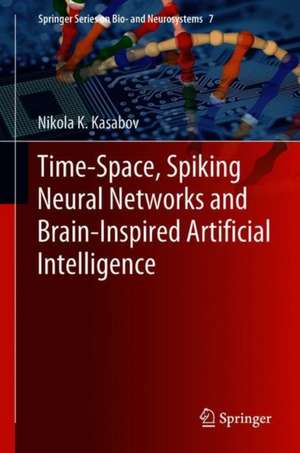Time-Space, Spiking Neural Networks and Brain-Inspired Artificial Intelligence: Springer Series on Bio- and Neurosystems, cartea 7
Autor Nikola K. Kasaboven Limba Engleză Hardback – 6 sep 2018
| Toate formatele și edițiile | Preț | Express |
|---|---|---|
| Paperback (1) | 1750.58 lei 6-8 săpt. | |
| Springer Berlin, Heidelberg – 19 ian 2019 | 1750.58 lei 6-8 săpt. | |
| Hardback (1) | 1757.34 lei 6-8 săpt. | |
| Springer Berlin, Heidelberg – 6 sep 2018 | 1757.34 lei 6-8 săpt. |
Preț: 1757.34 lei
Preț vechi: 2196.68 lei
-20% Nou
Puncte Express: 2636
Preț estimativ în valută:
336.31€ • 365.18$ • 282.50£
336.31€ • 365.18$ • 282.50£
Carte tipărită la comandă
Livrare economică 22 aprilie-06 mai
Preluare comenzi: 021 569.72.76
Specificații
ISBN-13: 9783662577134
ISBN-10: 3662577135
Pagini: 250
Ilustrații: XXXIV, 738 p. 340 illus., 256 illus. in color.
Dimensiuni: 155 x 235 x 48 mm
Greutate: 1.25 kg
Ediția:1st ed. 2019
Editura: Springer Berlin, Heidelberg
Colecția Springer
Seria Springer Series on Bio- and Neurosystems
Locul publicării:Berlin, Heidelberg, Germany
ISBN-10: 3662577135
Pagini: 250
Ilustrații: XXXIV, 738 p. 340 illus., 256 illus. in color.
Dimensiuni: 155 x 235 x 48 mm
Greutate: 1.25 kg
Ediția:1st ed. 2019
Editura: Springer Berlin, Heidelberg
Colecția Springer
Seria Springer Series on Bio- and Neurosystems
Locul publicării:Berlin, Heidelberg, Germany
Cuprins
Part I. Time-Space and AI.- Part II. The Human Brain.- Part III. Spiking Neural Networks.- Part IV. SNN for Deep Learning and Deep Knowledge Representation of Brain Data.- Part V. SNN for Audio-Visual Data and Brain-Computer Interfaces.- Part VI. SNN in Bio- and Neuroinformatics.- Part VII. SNN for Deep in Time-Space Learning and Deep Knowledge Representation of Multisensory Streaming Data.- Part VIII. Future development in BI-SNN and BI-AI.
Notă biografică
Nikola Kirilov Kasabov is Professor of neural networks and knowledge engineering and Director of the Knowledge Engineering and Discovery Research Institute (KEDRI) at the Auckland University of Technology (AUT), New Zealand. Born in Bulgaria, he has worked previously at the TU Sofia, University of Essex and University of Otago. He is fellow of IEEE, Fellow of the Royal Society (Academy) of New Zealand (RSNZ), Distinguished Fellow of the Royal Academy of Engineering UK and Visiting Professor at several universities, including: Shanghai Jia-Tong University; ETH and University of Zurich; RGU Scotland UK; University of Trento; University of Kaiserslautern; Universities of Twente and Maastricht. Prof Kasabov originated methods and systems for intelligent information processing, including: evolving connectionist systems, hybrid neuro-fuzzy systems, evolving- and brain –inspired spiking neural network architectures, quantum-inspired methods, methods for personalised modelling in bio andneuroinformatics, published in more than 600 works. He is Past President of the International Neural Network Society (INNS) and the current President of the Asia-Pacific Neural Network Society (APNNS). Prof Kasabov has received the INNS Ada Lovelace and Gabor Awards, APNNS Outstanding Achievements Award, RSNZ Medal, AUT Medal, Honourable Fellowship of the Bulgarian and the Greek Computer Societies, Pavlikeni Honourable Citizenship and other awards. He has been the editor of the Springer Handbook of Bio-/Neuro-informatics published by Springer in 2014 and of the related book series Springer Series on Bio- and Neurosystems.
Textul de pe ultima copertă
Spiking neural networks (SNN) are biologically inspired computational models that represent and process information internally as trains of spikes. This monograph book presents the classical theory and applications of SNN, including original author’s contribution to the area. The book introduces for the first time not only deep learning and deep knowledge representation in the human brain and in brain-inspired SNN, but takes that further to develop new types of AI systems, called in the book brain-inspired AI (BI-AI). BI-AI systems are illustrated on: cognitive brain data, including EEG, fMRI and DTI; audio-visual data; brain-computer interfaces; personalized modelling in bio-neuroinformatics; multisensory streaming data modelling in finance, environment and ecology; data compression; neuromorphic hardware implementation. Future directions, such as the integration of multiple modalities, such as quantum-, molecular- and brain information processing, is presented in the last chapter. The book is a research book for postgraduate students, researchers and practitioners across wider areas, including computer and information sciences, engineering, applied mathematics, bio- and neurosciences.
Caracteristici
Presents background knowledge and new generic methods for spiking neural networks, evolving spiking neural networks and brain-inspired spiking neural networks Describes new specific methods for the creation of BI-AI systems Focuses on applications such as modeling and analysis of time-space data Includes supplementary material: sn.pub/extras









